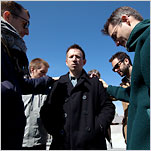The universe, it seems, has been operating with a dimmer switch.
The galaxies are actually twice as luminous as they appear to us in the sky, according to a new study by an international team of astronomers led by Simon Driver, of the University of St. Andrews in Scotland. Dust, however, blocks half the light from getting out.
The results, which have just been published in The Astrophysical Journal Letters, resolve a longstanding problem with the energy budget of the cosmos.
Interstellar dust absorbs the visible light emitted by stars and then re-radiates it as infrared, or heat, radiation. But when astronomers measured this heat glow from distant galaxies, the dust appeared to be putting out more energy than the stars.
“You can’t get more energy out than you put in, so we knew something was very wrong,” said Dr. Driver, in a press release issued by the Science and Facilities Council in the United Kingdom.
He and his colleagues embarked on a program of comparing a model of galactic dust with measurements of the light from 10,000 nearby galaxies using the Isaac Newton Telescope in the Canary Islands and other instruments. That allowed them to calculate by color what percentage of starlight was escaping the galaxies and getting to telescopes: 20 percent of short-wavelength ultraviolet light, 45 percent of green light, 75 percent of the red light, and so on.
The end result, that the stars in galaxies are actually pumping out twice as much energy as previously thought, was still a shock, Dr. Driver said. For the universe as a whole, they calculated, that amounts to 5 quadrillion watts per cubic light-year from thermonuclear fusion, a nice new number for those concerned about their cosmic carbon footprints.
The results also mean that there is about 20 percent more mass in stars than previously thought. But since stars make up such a small percentage of the universe to begin with — dark matter and dark energy account for 95 percent or so — it is a small adjustment over all.
“Basically increasing the stellar mass in the nearby universe by 20 percent has little impact,” Dr. Driver said in an e-mail message from Scotland.
The results will have more impact, he said, on comparative observations of nearby and faraway galaxies, where, he said, dust has not previously been taken into account.












